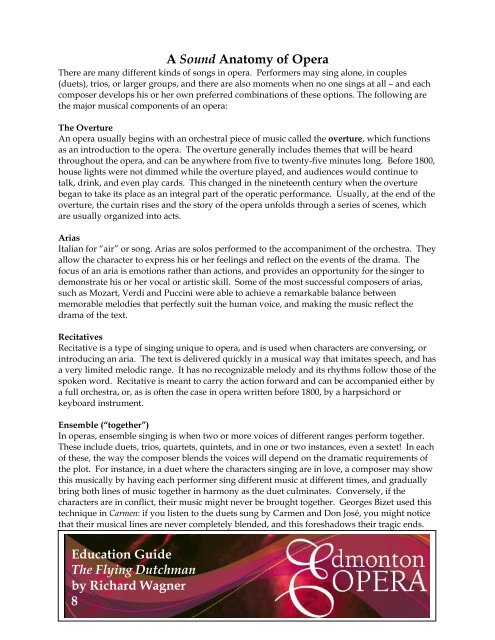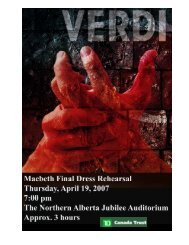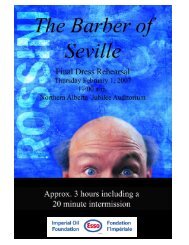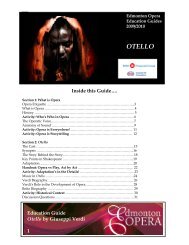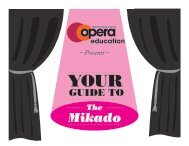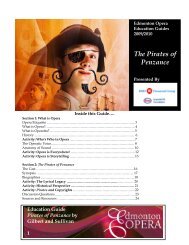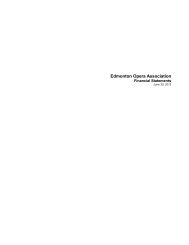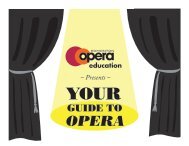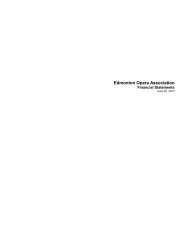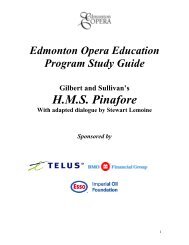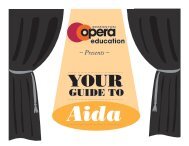Education Guide The Flying Dutchman by ... - Edmonton Opera
Education Guide The Flying Dutchman by ... - Edmonton Opera
Education Guide The Flying Dutchman by ... - Edmonton Opera
Create successful ePaper yourself
Turn your PDF publications into a flip-book with our unique Google optimized e-Paper software.
A Sound Anatomy of <strong>Opera</strong><br />
<strong>The</strong>re are many different kinds of songs in opera. Performers may sing alone, in couples<br />
(duets), trios, or larger groups, and there are also moments when no one sings at all – and each<br />
composer develops his or her own preferred combinations of these options. <strong>The</strong> following are<br />
the major musical components of an opera:<br />
<strong>The</strong> Overture<br />
An opera usually begins with an orchestral piece of music called the overture, which functions<br />
as an introduction to the opera. <strong>The</strong> overture generally includes themes that will be heard<br />
throughout the opera, and can be anywhere from five to twenty-five minutes long. Before 1800,<br />
house lights were not dimmed while the overture played, and audiences would continue to<br />
talk, drink, and even play cards. This changed in the nineteenth century when the overture<br />
began to take its place as an integral part of the operatic performance. Usually, at the end of the<br />
overture, the curtain rises and the story of the opera unfolds through a series of scenes, which<br />
are usually organized into acts.<br />
Arias<br />
Italian for “air” or song. Arias are solos performed to the accompaniment of the orchestra. <strong>The</strong>y<br />
allow the character to express his or her feelings and reflect on the events of the drama. <strong>The</strong><br />
focus of an aria is emotions rather than actions, and provides an opportunity for the singer to<br />
demonstrate his or her vocal or artistic skill. Some of the most successful composers of arias,<br />
such as Mozart, Verdi and Puccini were able to achieve a remarkable balance between<br />
memorable melodies that perfectly suit the human voice, and making the music reflect the<br />
drama of the text.<br />
Recitatives<br />
Recitative is a type of singing unique to opera, and is used when characters are conversing, or<br />
introducing an aria. <strong>The</strong> text is delivered quickly in a musical way that imitates speech, and has<br />
a very limited melodic range. It has no recognizable melody and its rhythms follow those of the<br />
spoken word. Recitative is meant to carry the action forward and can be accompanied either <strong>by</strong><br />
a full orchestra, or, as is often the case in opera written before 1800, <strong>by</strong> a harpsichord or<br />
keyboard instrument.<br />
Ensemble (“together”)<br />
In operas, ensemble singing is when two or more voices of different ranges perform together.<br />
<strong>The</strong>se include duets, trios, quartets, quintets, and in one or two instances, even a sextet! In each<br />
of these, the way the composer blends the voices will depend on the dramatic requirements of<br />
the plot. For instance, in a duet where the characters singing are in love, a composer may show<br />
this musically <strong>by</strong> having each performer sing different music at different times, and gradually<br />
bring both lines of music together in harmony as the duet culminates. Conversely, if the<br />
characters are in conflict, their music might never be brought together. Georges Bizet used this<br />
technique in Carmen: if you listen to the duets sung <strong>by</strong> Carmen and Don José, you might notice<br />
that their musical lines are never completely blended, and this foreshadows their tragic ends.<br />
<strong>Education</strong> <strong>Guide</strong><br />
<strong>The</strong> <strong>Flying</strong> <strong>Dutchman</strong><br />
<strong>by</strong> Richard Wagner<br />
8


